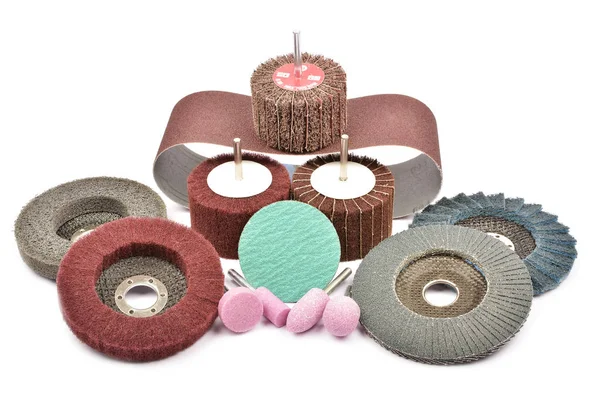Abrasives are indispensable tools in various industries, facilitating the shaping, finishing, and polishing of materials through grinding, cutting, or sanding processes. Among the diverse types of abrasives, understanding the nuances between bonded, coated, and non-woven abrasives is essential for selecting the most suitable tool for specific applications.
Bonded Abrasives
Bonded abrasives, recognized for their durability and versatility, consist of abrasive grains bound together by materials such as vitrified clay, resin, or rubber. This bonding material ensures controlled material removal in a variety of applications.
Types of Bonded Abrasives
- Grinding Wheels:Circular wheels with embedded abrasive grains, grinding wheels are instrumental in precision grinding operations common in metal fabrication and manufacturing.
- Mounted Points:Small, specialized abrasive tools mounted on spindles, these are ideal for intricate grinding operations, particularly in hard-to-reach areas.
- Segments: Blocks of abrasive material held together by a bonding agent, segments are frequently used in surface grinding applications to efficiently remove material from large surfaces.
- Cut-Off Wheels:These are thin, rigid wheels designed for cutting various materials, making them essential in metalworking and construction.
How Bonded Abrasives Are Made
Manufacturing bonded abrasives involves mixing abrasive grains with bonding agents, shaping the mixture into the desired form (such as wheels or segments), and then curing or baking the product to harden the bonding material.
How Bonded Abrasives Work
Bonded abrasives work by utilizing the abrasive grains to remove material from the workpiece through cutting, grinding, or finishing processes. The bonding material holds the grains in place, ensuring precision and control during the operation.
Benefits and Limitations of Bonded Abrasives
Benefits:
- Durability:Bonded abrasives are known for their robustness, making them suitable for heavy-duty applications.
- Precision:They offer precise control over material removal, making them ideal for applications requiring accuracy.
- Versatility: Bonded abrasives can be used on a variety of materials, including metal, ceramics, and composites.
Limitations:
- Heat Generation:In heavy use, bonded abrasives can generate heat, requiring careful consideration to prevent damage to the workpiece.
- Initial Cost:The upfront cost of bonded abrasives can be higher than other types, but their durability often justifies the investment.
Coated Abrasives
Coated abrasives, featuring abrasive grains on a flexible backing material, are valued for their versatility and conformability. This flexibility makes them suitable for applications where a more adaptable abrasive is necessary.
Types of Coated Abrasives
- Sandpaper:A familiar form of coated abrasives, sandpaper consists of abrasive grains adhered to paper or cloth backing. It is widely used for hand sanding and power tool applications.
- Abrasive Belts:Continuous loops of coated abrasive material used in belt sanders, these belts are efficient for large surface areas and are common in woodworking and metalworking.
- Flap Discs:These discs feature overlapping flaps of coated abrasive material attached to a central hub, making them effective for blending and finishing applications in metal fabrication.
How Coated Abrasives Are Made
The production of coated abrasives involves applying adhesive to a flexible backing material and then embedding abrasive grains into the adhesive. The coated product is then cured or dried, creating a flexible yet durable abrasive tool.
How Coated Abrasives Work
Coated abrasives work by allowing the abrasive grains to abrade the material as the flexible backing conforms to the surface. This conformability makes coated abrasives ideal for contoured or irregular surfaces.
Benefits and Limitations of Coated Abrasives
Benefits:
- Flexibility: Coated abrasives are flexible and conformable, making them suitable for irregular surfaces and contours.
- Versatility: They can be used for a wide range of applications, from hand sanding to automated machinery.
- Efficient Material Removal:Coated abrasives are effective for material removal and surface finishing.
Limitations:
- Wear Rate:Coated abrasives may experience a higher wear rate compared to bonded abrasives, requiring more frequent replacements.
- Heat Buildup: In heavy use, coated abrasives can generate heat, necessitating periodic breaks to prevent overheating.
Non-Woven Abrasives
Non-woven abrasives, characterized by a three-dimensional web of nylon fibers impregnated with abrasive grains, offer a unique cutting action that ensures consistency and precision.
Types of Non-Woven Abrasives
- Hand Pads: Versatile tools for cleaning, deburring, and finishing surfaces, non-woven hand pads find applications in metalworking and woodworking.
- Belts: Ideal for applications requiring conformability, non-woven abrasive beltsare used for blending and finishing on curved or contoured surfaces.
- Discs and Wheels: Used for surface preparation and finishing tasks, non-woven abrasive discsand wheels come in various diameters and densities to suit different applications.
How Non-Woven Abrasives Are Made
Manufacturing non-woven abrasives involves bonding abrasive grains to a three-dimensional nylon web. The impregnation process ensures a consistent distribution of abrasive material, creating a tool with controlled cutting action.
How Non-Woven Abrasives Work
Non-woven abrasives work by allowing the nylon fibers to conform to the surface, while the embedded abrasive grains perform the cutting action. This unique structure results in a consistent finish without the risk of gouging or marring the workpiece.
Benefits and Limitations of Non-Woven Abrasives
Benefits:
- Consistent Finish: Non-woven abrasives provide a consistent finish without the risk of gouging or marring the workpiece.
- Cooler Operation: The open structure of non-woven abrasives allows for cooler operation, reducing the risk of heat-related damage to the workpiece.
- Versatility:Non-woven abrasives are effective on a wide range of materials, including metal, wood, and composites.
Limitations:
- Material Removal Rate: Non-woven abrasives may have a slower material removal rate compared to some bonded and coated abrasives.
- Initial Cost: While cost-effective in the long run, non-woven abrasives may have a higher initial cost.
Choosing the Right Abrasive
Selecting the appropriate abrasive involves considering the material type, application, tool compatibility, and surface finish requirements. Bonded abrasives are ideal for precision work, coated abrasives for flexibility, and non-woven abrasives for consistent finishing. Each type has its unique characteristics, advantages, and applications, and choosing wisely can lead to improved efficiency, precision, and overall success in various industries.


